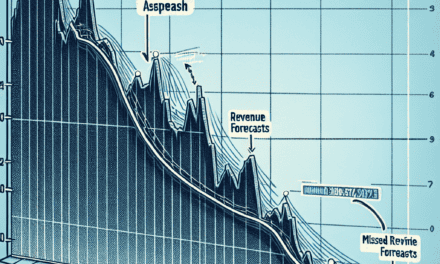“Rethinking Risks: Navigating the Uncertainty of ‘Trump Trades'”
Introduction
Investors are increasingly reevaluating the so-called “Trump trades” as policy uncertainty under the Trump administration grows. Initially, markets responded positively to President Trump’s promises of tax cuts, deregulation, and infrastructure spending, leading to a surge in stocks, particularly in sectors like financials and industrials. However, as legislative challenges and geopolitical tensions mount, the initial optimism is giving way to caution. Investors are now reassessing their strategies, weighing the potential benefits of Trump’s economic agenda against the risks posed by unpredictable policy shifts and international developments. This reconsideration reflects broader concerns about the sustainability of market gains in an environment marked by volatility and uncertainty.
Impact Of Policy Uncertainty On Market Volatility
In recent months, investors have been reevaluating their positions on so-called “Trump trades,” a term that gained prominence following the 2016 U.S. presidential election. These trades were initially characterized by a surge in market optimism, driven by expectations of pro-business policies such as tax cuts, deregulation, and infrastructure spending. However, as policy uncertainty grows, the impact on market volatility has become increasingly pronounced, prompting investors to reconsider their strategies.
Initially, the Trump administration’s promises of sweeping economic reforms led to a significant rally in equities, particularly in sectors like financials, industrials, and energy. Investors anticipated that deregulation would boost corporate profits, while tax reforms would increase disposable income and stimulate consumer spending. This optimism was reflected in the stock market’s performance, with major indices reaching record highs. However, as time progressed, the anticipated policies faced numerous hurdles, including political opposition, legislative gridlock, and shifting priorities within the administration itself.
As a result, the initial euphoria began to wane, giving way to a more cautious approach among investors. The unpredictability of policy implementation has introduced a new layer of complexity to market dynamics. For instance, the ongoing trade tensions and tariff disputes have created an environment of uncertainty that has affected global supply chains and corporate earnings forecasts. Consequently, market participants have had to navigate a landscape where policy announcements can lead to abrupt shifts in market sentiment.
Moreover, the lack of clarity regarding future policy directions has exacerbated market volatility. Investors, who once relied on the administration’s pro-business stance, now find themselves grappling with mixed signals. For example, while some deregulatory measures have been enacted, others remain stalled or have been reversed. This inconsistency has made it challenging for investors to assess the long-term implications of policy changes on their portfolios.
In addition to domestic policy uncertainty, geopolitical factors have also contributed to market volatility. The administration’s approach to international relations, characterized by unpredictability and frequent changes in stance, has heightened concerns among investors. The potential for sudden policy shifts, such as changes in trade agreements or foreign policy decisions, has added another layer of risk to the investment landscape.
To mitigate these risks, investors have increasingly turned to diversification and risk management strategies. By spreading their investments across different asset classes and geographic regions, they aim to reduce exposure to policy-driven volatility. Additionally, some investors have sought refuge in traditionally safer assets, such as bonds and gold, which tend to perform well during periods of uncertainty.
In conclusion, the growing policy uncertainty under the Trump administration has had a significant impact on market volatility, prompting investors to reassess their strategies. While the initial optimism surrounding “Trump trades” has faded, the current environment presents both challenges and opportunities. As investors navigate this complex landscape, they must remain vigilant and adaptable, ready to respond to the ever-changing policy environment. By doing so, they can better position themselves to manage risks and capitalize on potential market opportunities, even amid uncertainty.
Reassessing Infrastructure Investments In A Shifting Political Landscape
In recent years, the term “Trump trades” has become synonymous with investment strategies that capitalized on the policies and promises of the Trump administration. These trades often focused on sectors such as infrastructure, energy, and financial services, which were expected to benefit from deregulation, tax cuts, and increased government spending. However, as the political landscape shifts and policy uncertainty grows, investors are increasingly reassessing their positions in these areas, particularly in infrastructure investments.
Initially, the Trump administration’s ambitious infrastructure plans generated significant enthusiasm among investors. The promise of a $1 trillion infrastructure package aimed at revitalizing America’s roads, bridges, and public transportation systems was seen as a boon for construction companies, materials suppliers, and related industries. This optimism was further fueled by the administration’s focus on reducing regulatory hurdles, which was expected to expedite project approvals and implementation.
However, as time progressed, the anticipated infrastructure boom failed to materialize to the extent investors had hoped. Legislative gridlock and competing policy priorities, such as tax reform and healthcare, diverted attention and resources away from infrastructure initiatives. Consequently, the lack of substantial federal investment in infrastructure projects led to a reevaluation of the so-called “Trump trades” in this sector.
Moreover, the political landscape has continued to evolve, adding layers of complexity to investment decisions. The Biden administration, for instance, has introduced its own infrastructure proposals, which differ significantly in scope and focus from those of its predecessor. While the Biden plan emphasizes clean energy, climate resilience, and social equity, it also faces its own set of challenges in securing bipartisan support and navigating the legislative process.
In light of these developments, investors are adopting a more cautious approach, seeking to balance potential opportunities with the inherent risks of policy uncertainty. Some are diversifying their portfolios to include a broader range of infrastructure-related assets, such as renewable energy projects and technology-driven solutions, which align with current policy trends. Others are taking a wait-and-see approach, closely monitoring legislative progress and adjusting their strategies accordingly.
Furthermore, the global context cannot be ignored, as international trade dynamics and geopolitical tensions also influence infrastructure investments. The ongoing trade disputes and shifting alliances have the potential to impact supply chains, project costs, and market access, adding another layer of complexity to investment decisions.
In conclusion, the reassessment of infrastructure investments amid growing policy uncertainty reflects a broader trend among investors to adapt to an ever-changing political and economic environment. While the initial enthusiasm for “Trump trades” has waned, the evolving landscape presents new opportunities and challenges that require careful consideration and strategic planning. As investors navigate this shifting terrain, they must remain vigilant, informed, and flexible, ready to adjust their strategies in response to emerging trends and developments. Ultimately, the ability to anticipate and respond to these changes will be crucial in achieving long-term investment success in the infrastructure sector.
The Future Of Tax Reform Under Political Uncertainty
In recent months, investors have been reevaluating their positions on so-called “Trump trades,” a term that gained prominence following the 2016 U.S. presidential election. These trades were initially driven by expectations of significant policy changes under the Trump administration, particularly in areas such as tax reform, deregulation, and infrastructure spending. However, as political uncertainty grows, the future of these policies, especially tax reform, has become increasingly ambiguous, prompting investors to reassess their strategies.
Initially, the anticipation of sweeping tax reforms under President Trump led to a surge in market optimism. Investors were particularly hopeful about the proposed reduction in corporate tax rates, which was expected to boost corporate profits and, consequently, stock prices. This optimism was reflected in the stock market’s performance, with major indices reaching record highs. However, as time has passed, the legislative process has proven to be more complex and contentious than initially anticipated. The lack of consensus within Congress, coupled with shifting political dynamics, has cast doubt on the administration’s ability to deliver on its tax reform promises.
Moreover, the political landscape has become increasingly volatile, with various factors contributing to the uncertainty surrounding tax reform. The ongoing investigations into alleged Russian interference in the 2016 election, coupled with internal divisions within the Republican Party, have diverted attention and resources away from legislative priorities. Additionally, the upcoming midterm elections have further complicated the situation, as lawmakers are wary of making bold policy moves that could impact their electoral prospects. This political uncertainty has made it challenging for investors to predict the future trajectory of tax reform and its potential impact on the markets.
In light of these developments, investors are adopting a more cautious approach, reassessing their exposure to sectors that were expected to benefit from tax reform. For instance, financial stocks, which initially surged on the prospect of deregulation and tax cuts, have experienced increased volatility as doubts about the administration’s ability to implement its agenda have grown. Similarly, sectors such as infrastructure and manufacturing, which were expected to benefit from increased government spending, have also faced headwinds due to the lack of progress on key policy initiatives.
Furthermore, the uncertainty surrounding tax reform has prompted investors to seek refuge in more defensive assets. As a result, there has been a noticeable shift towards bonds and other fixed-income securities, which are perceived as safer investments in times of political and economic uncertainty. This shift in investor sentiment underscores the growing skepticism about the administration’s ability to deliver on its policy promises and the potential implications for the broader economy.
In conclusion, the future of tax reform under the current political climate remains uncertain, and this uncertainty is having a profound impact on investor behavior. As the legislative process continues to unfold, investors will need to remain vigilant, closely monitoring developments in Washington and adjusting their strategies accordingly. While the initial optimism surrounding “Trump trades” has waned, the evolving political landscape presents both challenges and opportunities for investors. By staying informed and adaptable, investors can navigate this period of uncertainty and position themselves for success in the ever-changing market environment.
Trade Policies And Their Influence On Investor Confidence
In recent years, the term “Trump trades” has become synonymous with investment strategies that capitalized on the economic policies and rhetoric of former President Donald Trump. These trades often involved sectors such as manufacturing, energy, and financial services, which were expected to benefit from deregulation, tax cuts, and a more protectionist trade stance. However, as the political landscape continues to evolve, investors are increasingly reconsidering these strategies amid growing policy uncertainty.
Initially, the Trump administration’s approach to trade was characterized by a series of aggressive moves, including the imposition of tariffs on imports from key trading partners like China and the renegotiation of trade agreements such as NAFTA, which was replaced by the USMCA. These actions were intended to bolster domestic industries and reduce trade deficits. Consequently, investors flocked to sectors that were perceived to be beneficiaries of these policies, driving up stock prices and creating a wave of optimism in the market.
Nevertheless, the long-term implications of these trade policies have proven to be more complex than initially anticipated. While some industries experienced short-term gains, others faced significant challenges due to retaliatory tariffs and disrupted supply chains. As a result, the initial enthusiasm surrounding Trump trades began to wane, prompting investors to reassess their positions.
Moreover, the transition to a new administration has introduced additional layers of uncertainty. President Joe Biden’s approach to trade policy, while distinct from his predecessor’s, has not yet fully clarified the future direction of U.S. trade relations. Although Biden has signaled a willingness to engage in multilateral trade negotiations and rebuild alliances, the specifics of his trade agenda remain somewhat ambiguous. This lack of clarity has left investors in a state of flux, as they attempt to navigate the shifting policy landscape.
In addition to the changing political environment, global economic conditions have also influenced investor sentiment. The COVID-19 pandemic has underscored the vulnerabilities of global supply chains and highlighted the need for greater resilience. Consequently, there is a growing emphasis on diversifying supply sources and investing in domestic production capabilities. This shift in focus has further complicated the outlook for Trump trades, as investors weigh the potential benefits of reshoring against the risks of continued trade tensions.
Furthermore, the rise of environmental, social, and governance (ESG) considerations has added another dimension to investment decisions. As more investors prioritize sustainability and ethical practices, sectors traditionally associated with Trump trades, such as fossil fuels, may face increased scrutiny. This trend underscores the importance of adapting investment strategies to align with evolving market dynamics and societal expectations.
In light of these factors, investors are increasingly adopting a more cautious approach. Diversification and risk management have become paramount, as market participants seek to mitigate the potential impact of policy shifts and economic uncertainties. While some may still find opportunities within the framework of Trump trades, others are exploring alternative strategies that offer greater resilience and adaptability.
Ultimately, the reconsideration of Trump trades reflects a broader recognition of the complexities inherent in navigating today’s interconnected global economy. As investors grapple with the interplay of trade policies, geopolitical developments, and emerging trends, the need for informed decision-making and strategic foresight has never been more critical. By staying attuned to these dynamics, investors can better position themselves to capitalize on opportunities while safeguarding against potential risks.
Energy Sector Investments: Navigating Uncertain Regulatory Changes
In recent years, the energy sector has been a focal point for investors seeking to capitalize on policy-driven opportunities. The so-called “Trump trades,” which gained prominence during the previous administration, were characterized by a surge in investments in fossil fuels and deregulation-driven growth. However, as the political landscape shifts and regulatory uncertainties loom, investors are increasingly reevaluating their strategies within the energy sector. This reconsideration is driven by a complex interplay of factors, including evolving regulatory frameworks, market dynamics, and the global push towards sustainable energy solutions.
To begin with, the regulatory environment is undergoing significant changes that are reshaping the energy investment landscape. The current administration has signaled a strong commitment to addressing climate change, which includes rejoining international agreements and setting ambitious targets for reducing carbon emissions. Consequently, there is a growing emphasis on renewable energy sources such as wind, solar, and hydroelectric power. This shift in policy focus is prompting investors to reassess their portfolios, as traditional fossil fuel investments may face increased regulatory scrutiny and potential financial risks.
Moreover, the market dynamics within the energy sector are evolving rapidly. Technological advancements and decreasing costs have made renewable energy sources more competitive with traditional fossil fuels. As a result, there is a noticeable trend towards diversifying energy portfolios to include a greater proportion of renewables. Investors are increasingly recognizing the long-term potential of sustainable energy solutions, not only as a means to mitigate regulatory risks but also as a strategic move to capitalize on the growing demand for clean energy. This transition is further supported by the increasing availability of green financing options, which provide investors with the necessary capital to explore and expand their renewable energy investments.
In addition to regulatory and market factors, the global push towards sustainability is exerting pressure on investors to align their strategies with environmental, social, and governance (ESG) criteria. Institutional investors, in particular, are facing mounting expectations from stakeholders to demonstrate their commitment to sustainable practices. This shift in investor sentiment is driving a reevaluation of energy sector investments, as companies with strong ESG credentials are increasingly viewed as more resilient and better positioned for long-term growth. Consequently, there is a growing interest in companies that are actively transitioning towards cleaner energy solutions and demonstrating a commitment to reducing their carbon footprint.
Despite these trends, it is important to acknowledge that the transition towards renewable energy is not without its challenges. The energy sector is inherently complex, and the shift from fossil fuels to renewables requires significant infrastructure investments and technological innovations. Additionally, geopolitical factors and supply chain disruptions can pose risks to the stability and reliability of energy supplies. Therefore, investors must carefully navigate these uncertainties and adopt a balanced approach that considers both the opportunities and risks associated with energy sector investments.
In conclusion, as policy uncertainty continues to shape the energy sector, investors are increasingly reconsidering their strategies in light of evolving regulatory frameworks, market dynamics, and sustainability imperatives. The shift away from traditional “Trump trades” towards more diversified and sustainable energy portfolios reflects a broader recognition of the need to adapt to changing circumstances. By embracing this transition, investors can position themselves to capitalize on the opportunities presented by the global shift towards cleaner energy solutions while mitigating potential risks associated with regulatory changes and market volatility.
Financial Sector Reforms: What Investors Need To Know
In recent years, the financial sector has been significantly influenced by the so-called “Trump trades,” a term that refers to investment strategies that gained popularity following the election of Donald Trump as President of the United States. These strategies were largely predicated on expectations of deregulation, tax cuts, and infrastructure spending, which were anticipated to stimulate economic growth and boost corporate profits. However, as policy uncertainty grows, investors are increasingly reconsidering these trades, prompting a reevaluation of their portfolios and strategies.
Initially, the Trump administration’s promises of sweeping tax reforms and deregulation led to a surge in market optimism. Investors flocked to sectors such as financials, industrials, and energy, anticipating that these industries would benefit most from the proposed policies. The financial sector, in particular, was buoyed by expectations of reduced regulatory burdens, which were seen as a catalyst for increased profitability and expansion. However, as time has passed, the anticipated policy changes have not materialized to the extent that many investors had hoped. This has led to a reassessment of the viability of these trades.
One of the primary factors contributing to this growing uncertainty is the complex and often contentious nature of the legislative process. While the Trump administration succeeded in passing significant tax reform in 2017, other initiatives, such as large-scale infrastructure spending and comprehensive deregulation, have faced numerous obstacles. Political gridlock, shifting priorities, and opposition from various stakeholders have all played a role in stalling these efforts. Consequently, investors who initially bet on rapid policy implementation have had to adjust their expectations and strategies accordingly.
Moreover, the evolving geopolitical landscape has added another layer of complexity to the investment environment. Trade tensions, particularly between the United States and China, have introduced additional risks and uncertainties. These tensions have the potential to disrupt global supply chains, impact corporate earnings, and influence market sentiment. As a result, investors are increasingly cautious, seeking to balance potential opportunities with the risks associated with an unpredictable policy environment.
In light of these challenges, investors are now focusing on a more diversified approach to their portfolios. Rather than relying solely on sectors that were expected to benefit from Trump-era policies, they are considering a broader range of investment opportunities. This includes looking at sectors that may be less directly impacted by policy changes, such as technology and healthcare, which have shown resilience and growth potential in recent years. Additionally, investors are paying closer attention to global markets, recognizing that opportunities may exist beyond the U.S. borders.
Furthermore, the importance of risk management has become more pronounced. Investors are increasingly employing strategies to hedge against potential market volatility and policy shifts. This includes the use of derivatives, diversification across asset classes, and a greater emphasis on fundamental analysis to identify companies with strong financial health and sustainable business models.
In conclusion, as policy uncertainty continues to shape the investment landscape, investors are reevaluating the assumptions that underpinned the “Trump trades.” By adopting a more diversified and risk-aware approach, they aim to navigate the complexities of the current environment while seeking opportunities for growth. As the financial sector continues to evolve, staying informed and adaptable will be crucial for investors looking to achieve their long-term objectives.
The Role Of Geopolitical Risks In Shaping Investment Strategies
In recent years, the investment landscape has been significantly influenced by geopolitical developments, with the so-called “Trump trades” emerging as a notable phenomenon. These trades, characterized by investments in sectors expected to benefit from the policies of former President Donald Trump, such as deregulation, tax cuts, and infrastructure spending, initially garnered substantial attention and capital. However, as policy uncertainty grows, investors are increasingly reconsidering their positions in these trades, highlighting the critical role of geopolitical risks in shaping investment strategies.
To understand the dynamics at play, it is essential to consider the initial appeal of Trump trades. The promise of a business-friendly environment, coupled with anticipated fiscal stimulus, led to a surge in investor confidence. Sectors such as financials, energy, and industrials were particularly favored, as they were expected to benefit directly from deregulation and increased government spending. This optimism was reflected in the stock market, with indices reaching record highs and volatility remaining relatively low.
Nevertheless, the landscape has shifted considerably since those early days. As the political climate becomes increasingly unpredictable, investors are faced with the challenge of navigating an environment fraught with uncertainty. The unpredictability of policy decisions, coupled with heightened geopolitical tensions, has introduced a level of risk that cannot be ignored. Consequently, investors are reevaluating their strategies, seeking to mitigate potential losses while capitalizing on emerging opportunities.
One of the primary factors contributing to this reassessment is the realization that policy implementation is often more complex and protracted than initially anticipated. While the rhetoric surrounding deregulation and tax reform was compelling, the actual legislative process proved to be more cumbersome. This disconnect between expectation and reality has led to a recalibration of investor expectations, prompting a more cautious approach.
Moreover, geopolitical risks extend beyond domestic policy considerations. International relations, trade agreements, and global economic conditions all play a pivotal role in shaping investment strategies. The escalating trade tensions between the United States and other major economies, for instance, have introduced a new layer of complexity. Tariffs and trade barriers have the potential to disrupt supply chains, impact corporate earnings, and ultimately influence market sentiment. As a result, investors are increasingly factoring in these external variables when making investment decisions.
In light of these developments, diversification has emerged as a key strategy for managing geopolitical risks. By spreading investments across different asset classes, sectors, and geographic regions, investors can reduce their exposure to any single source of risk. This approach not only helps to mitigate potential losses but also positions investors to take advantage of opportunities that may arise in different markets.
Furthermore, the growing importance of environmental, social, and governance (ESG) factors in investment decisions cannot be overlooked. As geopolitical risks continue to evolve, investors are placing greater emphasis on sustainability and ethical considerations. Companies that demonstrate resilience in the face of geopolitical challenges and adhere to strong ESG principles are increasingly viewed as attractive investment opportunities.
In conclusion, the reconsideration of Trump trades amid growing policy uncertainty underscores the significant impact of geopolitical risks on investment strategies. As investors navigate this complex landscape, a nuanced understanding of both domestic and international factors is essential. By adopting a diversified approach and integrating ESG considerations, investors can better position themselves to manage risks and capitalize on opportunities in an ever-changing geopolitical environment.
Q&A
1. **What are ‘Trump Trades’?**
‘Trump Trades’ refer to investment strategies and market movements that were influenced by the policies and promises made by Donald Trump during his presidency, such as tax cuts, deregulation, and infrastructure spending.
2. **Why are investors reconsidering ‘Trump Trades’?**
Investors are reconsidering ‘Trump Trades’ due to growing uncertainty about the implementation and impact of Trump’s policies, as well as potential political and economic challenges.
3. **What factors contribute to the policy uncertainty?**
Factors contributing to policy uncertainty include political opposition, legislative hurdles, and potential changes in administration priorities or global economic conditions.
4. **How has policy uncertainty affected the stock market?**
Policy uncertainty has led to increased volatility in the stock market, with investors becoming more cautious and some sectors experiencing fluctuations based on perceived policy impacts.
5. **Which sectors were initially boosted by ‘Trump Trades’?**
Sectors such as financials, industrials, and energy were initially boosted by ‘Trump Trades’ due to expectations of deregulation, infrastructure spending, and favorable tax policies.
6. **What are investors doing in response to the uncertainty?**
In response to the uncertainty, investors are diversifying their portfolios, seeking safer assets, and closely monitoring policy developments to adjust their strategies accordingly.
7. **What is the potential impact of policy uncertainty on future investments?**
The potential impact of policy uncertainty on future investments includes reduced investor confidence, delayed investment decisions, and a shift towards more conservative or globally diversified investment strategies.
Conclusion
Investors are reassessing the so-called “Trump trades” due to increasing uncertainty surrounding policy implementation and potential shifts in the political landscape. Initially, these trades were driven by expectations of tax cuts, deregulation, and infrastructure spending under the Trump administration, which were anticipated to boost economic growth and corporate profits. However, as policy proposals face legislative hurdles and geopolitical tensions rise, market participants are becoming more cautious. This growing uncertainty is prompting a reevaluation of investment strategies, with some investors opting for a more defensive approach or diversifying their portfolios to mitigate potential risks associated with the volatility of policy outcomes.





